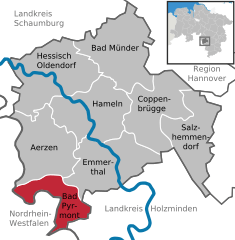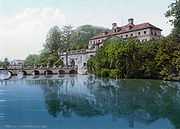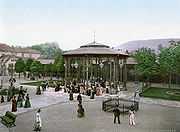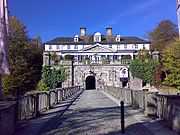Bad Pyrmont
| Bad Pyrmont | ||
|---|---|---|
|
Train station | ||
| ||
 Bad Pyrmont | ||
Location of Bad Pyrmont within Hameln-Pyrmont district 
 | ||
| Coordinates: 51°59′12″N 09°15′49″E / 51.98667°N 9.26361°ECoordinates: 51°59′12″N 09°15′49″E / 51.98667°N 9.26361°E | ||
| Country | Germany | |
| State | Lower Saxony | |
| District | Hameln-Pyrmont | |
| Government | ||
| • Mayor | Klaus Blome (Ind.) | |
| Area | ||
| • Total | 61.96 km2 (23.92 sq mi) | |
| Population (2013-12-31)[1] | ||
| • Total | 18,909 | |
| • Density | 310/km2 (790/sq mi) | |
| Time zone | CET/CEST (UTC+1/+2) | |
| Postal codes | 31812 | |
| Dialling codes | 05281 | |
| Vehicle registration | HM | |
| Website | www.stadt-badpyrmont.de | |
| County (Principality) of Pyrmont | |||||
| Grafschaft (Fürstentum) Pyrmont | |||||
| State of the Holy Roman Empire, State of the Confederation of the Rhine, State of the German Confederation, State of the North German Confederation, State of the German Empire | |||||
| |||||
| Capital | Pyrmont, Lügde | ||||
| Government | Principality | ||||
| Historical era | Middle Ages | ||||
| - | Partitioned from Schwalenberg |
1194 | |||
| - | Comital line extinct; to Spiegelberg, Lippe, Gleichen |
1494, 1557, 1583 | |||
| - | To Waldeck | 1625 | |||
| - | Regained independ. | 1805–12 | |||
| - | Prussian admin. | from 1868 | |||
| - | German Revolution | 1918 | |||
| - | Joined Prussian province of Hanover |
1921 | |||
Bad Pyrmont (German pronunciation: [bat pyrˈmɔnt, ˈpyrmɔnt]) is a town in the district of Hamelin-Pyrmont, in Lower Saxony (Niedersachsen), Germany, with a population of 22,000 (2003). It is located on the River Emmer, about 10 km west of the Weser, and a popular spa resort that gained its reputation as a fashionable place for princely vacations in the 17th and 18th centuries. Its large park is among the most spectacular in Germany, with a renowned outdoor palm garden. The baroque castle (1706–10) is part of an impressive complex of fortifications from the 16th century. The castle now houses the Museum of Municipal and Spa History. Unique in Europe is the vapor cave, where therapeutic carbon dioxide vapors emerge from the earth. The town is also the center of the Religious Society of Friends (Quakers) in Germany. Bad Pyrmonter mineral water, popular throughout northern Germany, is bottled in Bad Pyrmont.
History
Formerly called Pyrmont, it was the seat of a small county during much of the Middle Ages. The county gained its independence, from the county of Schwalenberg, in 1194. Independence was maintained until the extinction of the comital line in 1494, when the county was inherited by the county of Spiegelberg. In 1557, the county was inherited by Lippe, then by the county of Gleichen in 1583.
In 1625 the county became part of the much larger county of Waldeck through inheritance. In 1668, the Reichskammergericht ruled against the Bishopric of Paderborn's claims that Pyrmont had been collateral in a loan, confirming the Count of Waldeck's rights over Pyrmont, who ceded the Amt of Lügde — previously the county's capital — to the bishopric in compensation. In January 1712 the count of Waldeck and Pyrmont was elevated to hereditary prince by Emperor Charles VI, the count having combined the two titles the previous year.
For a brief period, from 1805 to 1812, Pyrmont was again a separate principality as a result of inheritance and partition after the death of the previous prince, but the two parts were united again in 1812. The principality of Waldeck-Pyrmont retained its status after the Congress of Vienna of 1815 and became a member of the German Confederation. In 1813, the inhabitants of Pyrmont began to protest at their lack of autonomy within Waldeck–Pyrmont and the separate constitutional nature of the two territories was confirmed the following year, until a formal union was established in 1849.
From 1868 onward, the principality was administered by Prussia, but retained its legislative sovereignty. Prussian administration served to reduce administrative costs for the small state and was based on a ten-year contract that was repeatedly renewed. In 1871 it became a constituent state of the new German Empire. At the end of World War I, during the German Revolution the prince abdicated and Waldeck–Pyrmont became a free state within the Weimar Republic. On 30 November 1921, following a local plebiscite, the town and district of Pyrmont were detached and incorporated into the Prussian Province of Hanover, with Waldeck following into the Prussian province of Hesse-Nassau in 1929.
Facilities
Country Clubs
Bad Pyrmont is a town with many country clubs and clinics. It has lots of spare time activities for older people, and local people commonly describe Bad Pyrmont as "one big old peoples' home".
Hospitals
Bad Pyrmont is well known for its Bathildis Hospital. The clinic is specialised for diseases related to the backbone and nerves, people from all over Germany come to get treatments within the relatively small clinic because of the success of its doctors, and because of the historic bath town infrastructure and comforts, especially for old people.
Thermal spring
Bad Pyrmont is a spa resort known for its gardens and its thermal spring Hufeland Therme which has incredible indoor and a warm outdoor pool as well as several saunas.
Famous citizens
- Max Born, Physicist, Nobel Prize Winner and grandfather of Olivia Newton-John
Gallery
|
See also
References
External links
| Wikimedia Commons has media related to Bad Pyrmont. |
Multimedia
| ||||||||





